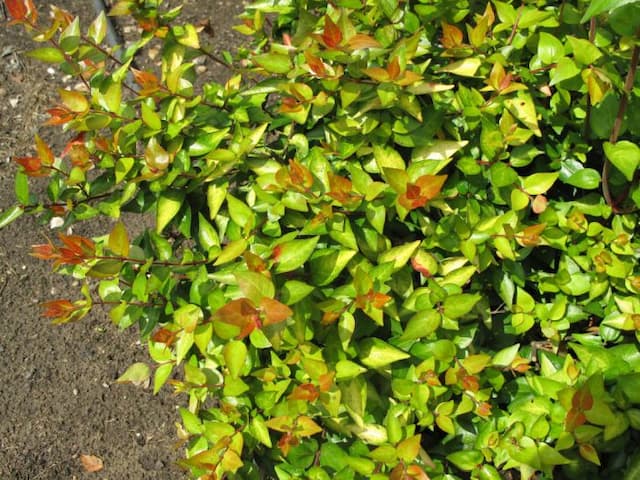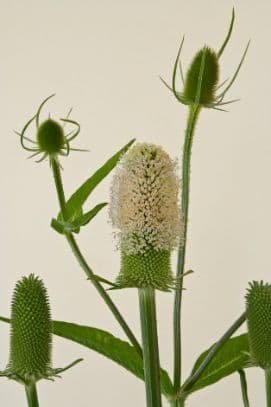Southern Bush Honeysuckle Diervilla sessilifolia

ABOUT
The plant known as the Southern bush honeysuckle is a deciduous shrub with a generally rounded shape. It has pointed, ovate leaves that grow opposite each other along the branches. The leaves are typically a medium to dark green color and can turn to a delightful yellow or sometimes reddish hue in the fall, creating an attractive autumn display. One of the signature characteristics of the Southern bush honeysuckle is its flowers. These are small, trumpet-shaped blooms ranging in color from pale yellow to a more vibrant yellow, sometimes with a reddish tinge on the outside. The flowers appear in clusters at the ends of the branches and provide a showy display from late spring into the summer, attracting pollinators such as bees and butterflies to the garden. The shrub also bears fruit that is not as conspicuous as its flowers. The fruits are small capsules that mature in late summer to early fall and provide food for some bird species. The bark of the Southern bush honeysuckle is tan to gray, often with a slightly exfoliating texture that adds interest, especially in the winter months when the leaves have fallen. Overall, the plant contributes to any garden with its seasonal changes and wildlife-friendly characteristics.
About this plant
 Names
NamesFamily
Caprifoliaceae
Synonyms
Southern Bush Honeysuckle,Southern Honeysuckle
Common names
Diervilla sessilifolia
 Toxicity
ToxicityTo humans
The plant known as Southern Bush Honeysuckle is not commonly reported as toxic to humans. There is no significant evidence to suggest that the ingestion or handling of Southern Bush Honeysuckle presents any considerable risk of poisoning to humans. Nonetheless, it is always a good practice to avoid eating plants unless you are certain they are safe, as individual sensitivities can vary.
To pets
The plant known as Southern Bush Honeysuckle is not commonly reported as toxic to pets. It is not listed among the toxic plants by major pet poison control resources. Therefore, the Southern Bush Honeysuckle is generally considered safe for pets, and there is no well-documented risk of poisoning from ingestion of this plant. However, pet owners should always monitor their pets for any unusual symptoms after ingestion of any plant material as individual animals might have different reactions.
 Characteristics
CharacteristicsLife cycle
Perennials
Foliage type
Deciduous
Color of leaves
Green
Flower color
Yellow
Height
3-4 feet (0.9-1.2 meters)
Spread
3-4 feet (0.9-1.2 meters)
Plant type
Shrub
Hardiness zones
4
Native area
Southeastern United States
Benefits
 General Benefits
General Benefits- Low maintenance: Diervilla sessilifolia, commonly known as Southern Bush Honeysuckle, is a hardy plant that requires minimal care once established.
- Drought resistant: It can withstand periods of low water availability, making it suitable for xeriscaping or gardens in dry climates.
- Erosion control: The plant has an extensive root system that helps stabilize soil and prevent erosion on slopes.
- Attracts pollinators: The trumpet-shaped flowers of the Southern Bush Honeysuckle are attractive to bees, butterflies, and other beneficial insects.
- Adaptable to various soils: This plant can thrive in a range of soil types, from sandy to loamy and even clay soils, as long as they are well-drained.
- Shade tolerant: While it prefers full sun, it can also tolerate partial shade, making it versatile for different garden designs.
- Natural habitat support: It serves as a food source and habitat for native fauna, contributing to local biodiversity.
- Aesthetic appeal: With its attractive yellow flowers and vibrant green foliage, it adds visual interest to gardens and landscapes.
- Seasonal interest: Southern Bush Honeysuckle provides seasonal interest with its spring to summer blooming period and sometimes with a display of fall foliage color.
- Naturalizing: The plant can naturalize in appropriate conditions, creating a low-maintenance, natural-looking landscape.
 Medical Properties
Medical PropertiesThis plant is not used for medical purposes.
 Air-purifying Qualities
Air-purifying QualitiesThis plant is not specifically known for air purifying qualities.
 Other Uses
Other Uses- Woven Goods: The flexible stems of the Southern Bush Honeysuckle can be used in basketry or woven to make small crafts or garden ornaments.
- Erosion Control: Due to its robust root system, the plant is effective in stabilizing soil and preventing erosion on slopes and banks.
- Natural Dyes: The leaves and bark might be utilized to create natural dyes for fabrics or crafts, although specific colors and processes are not well documented.
- Wildlife Habitat: Provides cover and nesting opportunities for small animals and insects within a garden or wild setting.
- Decorative Branches: The plant's branches can be pruned and used for rustic decorative elements in floral arrangements or as part of natural art installations.
- Photography: This plant, with its attractive flowers, can be a subject for nature photography, benefiting hobbyist photographers or as a teaching tool in photography classes focusing on plant life.
- Education and Research: Can serve as a subject for botanical studies or educational programs in schools to demonstrate plant growth, pollination, and local flora biodiversity.
- Garden Borders: Its dense foliage and mounding habit makes it a suitable option for creating borders in gardens or along walkways.
- Seasonal Interest: Its changing foliage colors add aesthetic value to gardens throughout the seasons, making it useful in landscape design for year-round visual interest.
- Culinary Experiments: While not a common use, adventurous chefs might experiment with its flowers or young shoots in culinary dishes, but caution is advised as not all parts may be edible or palatable.
Interesting Facts
 Feng Shui
Feng ShuiThe Southern Bush Honeysuckle is not used in Feng Shui practice.
 Zodiac Sign Compitability
Zodiac Sign CompitabilityThe Southern Bush Honeysuckle is not used in astrology practice.
 Plant Symbolism
Plant Symbolism- Hardiness: Diervilla sessilifolia, commonly known as the Southern Bush Honeysuckle, is a rugged plant, able to adapt and thrive in tough conditions which symbolizes strength and resilience.
- Adaptability: Its ability to grow in various soil types and withstand partial shade to full sun reflects a symbol of adaptability and versatility.
- Low Maintenance: This plant does not require much care to flourish, symbolizing independence and self-sufficiency.
- Support for wildlife: As it attracts pollinators like bees and butterflies, it represents support and sustenance for others, highlighting the importance of relationships and community.
 Water
WaterThe common name for Diervilla sessilifolia is Southern Bush Honeysuckle. Southern Bush Honeysuckle prefers consistent moisture but is also drought tolerant once established. During the first growing season, water the plant deeply once a week, providing about 1-2 gallons per watering to establish a strong root system. After establishment, you can reduce watering frequency, but during dry periods or extreme heat, supplemental watering every 2-3 weeks may be necessary. Ensure the soil is well-draining to prevent root rot.
 Light
LightSouthern Bush Honeysuckle thrives in full sun to partial shade. The ideal spot for this plant would be an area that receives at least 6 hours of sunlight but is protected from the harsh afternoon sun, which can be too intense. Dappled sunlight under the canopy of taller trees or an eastern exposure are good locations for this plant.
 Temperature
TemperatureSouthern Bush Honeysuckle is quite hardy and can withstand a range of temperatures. It can survive in temperatures as low as -30°F and as high as 90°F. However, the ideal temperature range for growing Southern Bush Honeysuckle is between 60°F and 80°F. This temperature range promotes healthy growth and blooming.
 Pruning
PruningPrune Southern Bush Honeysuckle to maintain its shape and encourage bushier growth. The best time to prune is in late winter or early spring before new growth begins. Pruning can be performed annually, removing any dead or damaged wood and thinning out about one-third of the oldest stems to promote rejuvenation.
 Cleaning
CleaningAs needed
 Soil
SoilSouthern Bush Honeysuckle thrives in well-draining soil rich in organic matter with a pH range of 6.0 to 7.0. A mix of garden soil, compost, and a small amount of sand or perlite facilitates good drainage and fertility.
 Repotting
RepottingSouthern Bush Honeysuckle, being a shrub, generally does not need frequent repotting and is often planted directly in the ground. It may only need replanting if outgrowing its space or for soil replenishment.
 Humidity & Misting
Humidity & MistingSouthern Bush Honeysuckle is adaptable but prefers moderate humidity levels; it does not require specific humidity adjustments when grown in its natural outdoor range.
 Suitable locations
Suitable locationsIndoor
Ensure bright light, cool temps, and moist soil for Southern Bush Honeysuckle.
Outdoor
Plant in sun to part shade, moist well-draining soil for Southern Bush Honeysuckle.
Hardiness zone
4-8 USDA
 Life cycle
Life cycleSouthern bush honeysuckle (Diervilla sessilifolia) begins its life as a seed, which, upon germination, develops into a seedling with basic root structures and shoots. As it becomes an established plant, it grows leaves and stems, and during its vegetative stage, it spreads primarily through suckering and forms clumps. Once mature enough, the plant produces small yellow flowers in the late spring or early summer that attract pollinators such as bees and butterflies. Following pollination, these flowers give way to dry, capsule-like fruits containing seeds for propagation. The plant may go through several flowering and seeding cycles throughout its life, especially in the warm months of the year. In the autumn, the foliage often takes on attractive red or purplish tinges before the plant goes dormant in winter, ready for regrowth in the following spring.
 Propogation
PropogationPropogation time
Spring to early summer
The Southern bush honeysuckle (Diervilla sessilifolia) is most commonly propagated using softwood cuttings. This technique is typically implemented in late spring to early summer when new growth is still somewhat tender but has started to mature. To propagate by cuttings, a gardener would take a 4 to 6-inch (about 10 to 15 cm) length of stem that includes at least two sets of leaves. The lower leaves are removed, and the cut end is often dipped in rooting hormone to encourage root development. The cutting is then placed in a well-draining rooting medium, kept moist, and covered with a plastic dome or placed in a greenhouse to retain humidity. Roots usually develop within a few weeks, after which the new plants can be gradually acclimated to outdoor conditions before being planted in their final location.








